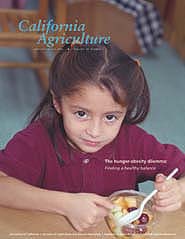All Issues

The hunger-obesity dilemma: Finding a healthy balance
Cover:
Food insecurity and overweight coexist at high rates among low-income populations for complex reasons (see page 12). UC nutrition educators are working to promote healthy food choices and lifestyle changes among children and adults. Photo by Ken Hammond, USDA .
January-March 2004
Volume 58, Number 1
Volume 58, Number 1





